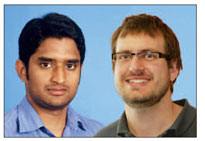The miniaturization of sensors and wireless systems is generating explosive growth in applications based on wearable electronic devices. At the Auto-ID Lab at the University of Adelaide, in Australia, we are working with the Queen Elizabeth Hospital and the Hospital Research Foundation to develop wearable sensor-equipped passive RFID tags for use in health-care applications, such as monitoring the daily activities of the elderly in hospitals and at home. Part of our research is aimed at developing lightweight, low-profile, low-cost antennas.
It is a considerable challenge to develop antennas that can be integrated with passive tag circuitry capable of delivering the power required to run the tag logic and sensory circuits, such as accelerometers. In particular, the antennas need to be concealable, flexible and designed for comfort, especially during the wearer’s sleep. It’s also essential that the electrical connections remain intact when the tags are worn around the clock.
Another challenge is that most antennas are easily detuned when located on or near a human body, resulting in reduced read range. Thus, the effects of human tissue, such as skin and fat, in close proximity to the antenna must be included in design considerations.
To address these problems, we are taking advantage of recent developments in conductive fabrics. Instead of using metal foil to construct an antenna, we use fabrics made from silver thread and conductive plastics. Generally, eliminating the effects of the human body on antenna performance requires the use of large metal sheets between the body and the antenna (ground plane). Such designs are not desirable for a wearable tag, so we use conductive fabrics to produce a barrier and achieve good performance. This produces a flexible antenna and a garment that can be easily laundered. In addition, we are building the antenna on low-cost, highly flexible substrates, such as foams, which ensures that the overall antenna structure does not cause discomfort to the wearer.With our design, the sensor-equipped ultrahigh-frequency tags have a read range of more than 4 meters (13 feet). This will reduce the cost of deployment, because fewer readers will be needed to capture the patient’s data at critical locations, such as near beds or chairs.
Our newest wearable tag antenna is designed to snap on and off, to facilitate laundering garments in hospitals. The ability to discard the tag supports protocols to control the spread of contagious diseases. Generally, hospitals prefer to discard used items, so keeping tag cost low is important. We estimate each tag would cost less than $3.
With the cost concern in mind, we are exploring other designs. One possibility is a snap-on tag that can be sterilized and reused. Another is to embroider antennas into fabric to create more flexible structures that can be easily integrated into clothing. We also plan to explore ways to ensure that the chip can survive the laundry process.
Damith Ranasinghe is the research director of the Auto-ID Lab at the University of Adelaide, in Australia. Thomas Kaufmann is a senior lab researcher.


